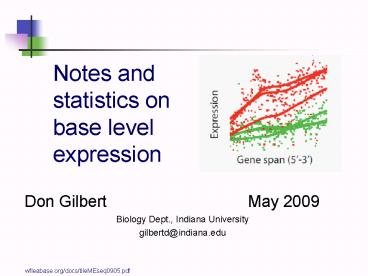Notes and statistics on base level expression - PowerPoint PPT Presentation
1 / 22
Title:
Notes and statistics on base level expression
Description:
Assessing the need for sequence-based normalization in tiling microarray experiments. ... or other sequence adjustments of expression, unless gene structure ... – PowerPoint PPT presentation
Number of Views:41
Avg rating:3.0/5.0
Title: Notes and statistics on base level expression
1
Notes and statistics on base level expression
May 2009
Don Gilbert
Biology Dept., Indiana University gilbertd_at_indiana
.edu
2
2007 Tile expression
DrosMel tiled by Affymetrix, finds new genes
(blue) and known (orange)
.
3
Precision improves 06-09
Measuring expression over gene structures,
Nimblegen (08) has higher precision than Affy
(06/07) RNA-Seq (09) has higher precision than
Nimblegen
.
4
microarray statistics for base level expression?
5
Gene or Base expression?
- Base-level expression (tiles, rna-seq) calculate
like gene differential expression (DE) - Per tile, per RNA-seq contig or per base
treatment - control - Combine for tiles over gene
- Independent (technically) observations, but
biologically related - Increase DF, Power with longer gene
- How to combine?
- As independent replicates gene gt (tiles,
technical, bio replicates)? - As nested block gene gt tiles gt replicates ?
- As gene average gene mean(tiles) gt replicates
? - Compare with gene-level stats
6
Gene or Base expression?
Base level tests find expression better than gene
average
Base level sensitivity 42, Gene level
sensitivity 38 Both have specificity 37
Sensitivity 1 - false
rejection Specificity 1 - false discovery
7
Gene or Base expression?
DE is consistent over gene span though expression
Ave changes gene-level measure can miss this.
Expression over gene span, treatment(red) vs
control(green) with 3 replicates
8
gene structures expression
9
Sequence normalizing?
Idea is to remove sequence (GC) effects on probe
hyb. score
TileScope Royce TE, Rozowsky JS, and Gerstein,
MB. (2007). Assessing the need for
sequence-based normalization in tiling microarray
experiments. Bioinformatics, 23, 988-997.
10
Sequence normalizing?
Sequence-normalizing also removes Exon/Intron
signal !
Dont use it (TileScopes quantilenorm) .. or
other sequence adjustments of expression, unless
gene structure signals are included.
11
Intron-Exon Detection
Nimblegen and Solexa tile/base expression detects
gene structure, on average, fairly well.
12
Intron-Exon Update
Newest RNA-Seq finds intron/exon very
well (Stranded RNA-Seq, modEncode Gingeras lab,
March 2009 )
13
Differential expression
Gene end (3) has more expression, but
Example genes
exons
introns
constant differential over gene span, on average.
Green is treatment, red control. Line style
shows 3 replicates of Daphnia tiled expression.
14
Diff. Expr. distributions
Genes
Introns
TARs
Introns show a null DE distribution, genes and
TAR regions are wider. Use introns as baseline
for statistics?
Pred
Metal
Sex
15
multiple testing corrections
16
Multiple statistic tests
- Problem perform 20,000 tests and p-values hit
laws of chance. Pr 0.05 can happen 1,000 times
by chance (false discovery, FDR). - DrosMel Affy line t-tests 2,284,383 / 5,395,023
0.42 Sig - Bonferroni conservative 0.03 Sig
- Benjamini Hochberg p.adjust(p,BH) 0.35 Sig
- qvalue(p) distribution based 0.41 Sig
- Storey, JD and R Tibshirani, 2003. Statistical
significance for genomewide studies. PNAS
1009440-9445 - SAM permutation qvalue
- However, p.adjust meant for 100s of tests, not
Millions - Drosmel modEncode case 1900 pairwise Affy cell
line (62 cells) DE comparisons x 14,000 genes
26,600,000 t-tests
17
Multiple DE tests Daphnia
- Much different corrections for experiments on
same genes - Daphnia DE 3 expt.s (trt - con), 25000 genes, 3
replicates - Predate, Metal genes have low expression,
important to detect
18
Multiple statistic tests
- Statisticians have turned p-value corrections
into an industry, but they are really more of a
band-aid than a solution - What about false rejection (FRR type II error)?
- Balance errors, false rejection maybe more
important - Solution 1 test fewer, directed hypotheses
- Solution 2 measure error rate on knowns, eg.
prediction of known genes - Solution 3 known null hypothesis, eg. introns
http//www.bioconductor.org/workshops/2009/Seattl
eApr09/DiffExpr/
19
1900 pairwise Affy cell line DE comparisons x
14,000 genes 26,600,000 t-tests
20
Hypotheses of interest are fewer 100s cells x
14,000 genes 2 Million tests
21
Summary
- Base-level expression (tiles, rna-seq) measures
gene expression better - Balances sensitivity (false rejection) with
specificity (false discovery) - Base-level expression measures gene structures
well - On average, and precision is improving for
individual genes. - Multiple test corrections are needed but
problematic - False discovery corrections for millions of tests
leads to false rejections. - Determine empirical error rates where possible
22
End note
- Summary pages
- wfleabase.org/genome-summaries/tile-expression/
- insects.eugenes.org/species/data/dmel5/modencode/
- Genome expression maps
- insects.eugenes.org8091/gbrowse/cgi-bin/gbrowse/d
rosmelme/ - expression in 52 cell lines (affy) and more
precise solexa nimblegen for a few cell lines - insects.eugenes.org8091/gbrowse/cgi-bin/gbrowse/d
aphnia_pulex8/ - expression among 4 treatment groups (sex, metal
stress, biotic predator) nimblegen
23
Differential expression
Gene models miss much expression
Known sex genes capture DE, but unknown regions
capture environmental stress expression, in
Daphnia.































